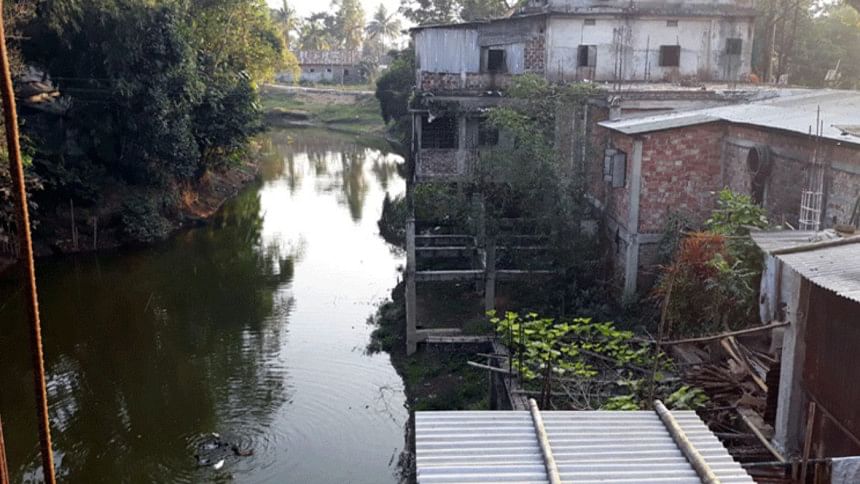The cry of small rivers from upstream

Hilly rivers from upstream are a lifeline to hundreds of rivers crisscrossing the riverine country that we live in. But topography of the river basins is changing significantly as many of these rivers, streaming down from India’s Meghalaya into Sunamganj, are shrinking fast due to encroachment.
Many rivers inland already disappeared and the rest might follow the same course -- a prospect that would deal a devastating blow to the geography, ecology, biodiversity and most importantly, the economy of the country.
With the natural course of many of these small streams or creeks, also called rivulets, destroyed by encroachers, water from upstream is oftentimes inundating low-lying areas in Sunamganj, causing heavy damage to farmers in the area.
All sorts of installations including markets, shops and residential houses have been built on these streams along the bordering areas of the district over the years. But the authorities concerned seem to be indifferent to the greater threat the illegal act poses to the country’s future.

Abdul Hye Al-Hadi, chief coordinator of Save the Heritage and Environment, said the main rivers and rivulets flowing through Sunamganj are originated in hilly areas of Meghalaya. They are the Surma, Kushiara, Kamarkhali, Kalni, Nokunda, Bowai, Nitai, Sonai, Gunai, Sameshwari and the Nawa.
Most of these are the principal tributaries of the two main rivers -- the Surma and the Kushiara, which are non-tidal and navigable throughout the year by country boats. The flowing length of theses rivers is about 195 kilometres.
The ecology and biodiversity as well as the socio-economy of people in the area completely depend on the existence of these rivers. These rivulets from hills have their unique characteristics, which are different than that of the plainland rivers in the country.
But with the intention to extract sand or stone from these as well as to encroach on the land, these rivulets are wrongly being identified as “quarries”. Moreover, no scientific method is being followed while extracting, which is in fact illegal, Abdul Hye said.
In the long run, these rivulets are losing their unique characteristics due to massive contamination and disposal of waste during extraction activities.
As a result, biodiversity in vast wetlands and haors is being affected and rivers all around are losing navigability, he added.
Mohabbatpur village resident Harunur Rashid from Doarabazar upazila said many influential locals set up shops occupying land on the Khasiamara river that is a tributary of the Surma river and runs through Lakkhipur and Surma unions after descending from Meghalaya.
The Khasiamara has practically died after around sixty-five shops were built on it in Mohabbatpur Bazar area over the past few years, he also said.
A local shop owner named Delwar Hossain, whose shop was removed from the river bank recently by assistant commissioner (land) of the upazila, claimed that his shop was not obstructing the river’s flow.
Surma Union Parishad Chairman Khandaker Mamunur Rashid said many houses have been built in Bangla Bazar area on the banks of the Bali river that runs through Bangla Bazar and falls on the Surma.
Since the river’s flow is obstructed, water overflowing from it now causes frequent flooding in the upazila, resulting in destruction of properties as well as the road between Bangla Bazar and Bhogla, he added.
Swapan Barman, president of Bishwambharpur Press Club, said many tributaries of the Surma run through Bishwambharpur upazila. Most of those tributaries, after originating in Meghalaya, falls on the Rakti river and the Rakti finally falls on the Surma.
One of them, the Dhamalia river, is on its death throes as many influential locals, including former UP chairman Rafiqul Islam Talukder, constructed several hundred houses on its banks, choking its natural flow.
Rafiqul Islam, however, denied causing any harm to the Dhamalia and claimed that his house was built far from the river.
Another of the tributaries, the Jadukata, is also under threat of extinction due to encroachment in Modergaon and Anwarpur areas, said Abdul Gani Ansari, an environmental activist from Muktikhola village.
Abdul Karim Kim, executive member of Bangladesh Poribesh Andolon, said, most of the rivers and streams -- such as Bali, Khasiamara, Dhamalia, Rakti, Ghatghatia and Old Jadukata -- that enter Sunamganj from Meghalaya are endangered due to illegal occupation.
These rivers will soon disappear from the geography of the area unless the illegal structures are removed from the rivers and stern action is taken immediately against the encroachers, he also said.
Contacted, Sunamganj Water Development Board Executive Engineer Sabibur Rahman said any structure found anywhere along the paths of the rivers will be removed.
Assuring due importance on the rivers and rivulets from upstream, he also said their drives against illegal encroachment on rivers are ongoing.

 For all latest news, follow The Daily Star's Google News channel.
For all latest news, follow The Daily Star's Google News channel. 



Comments